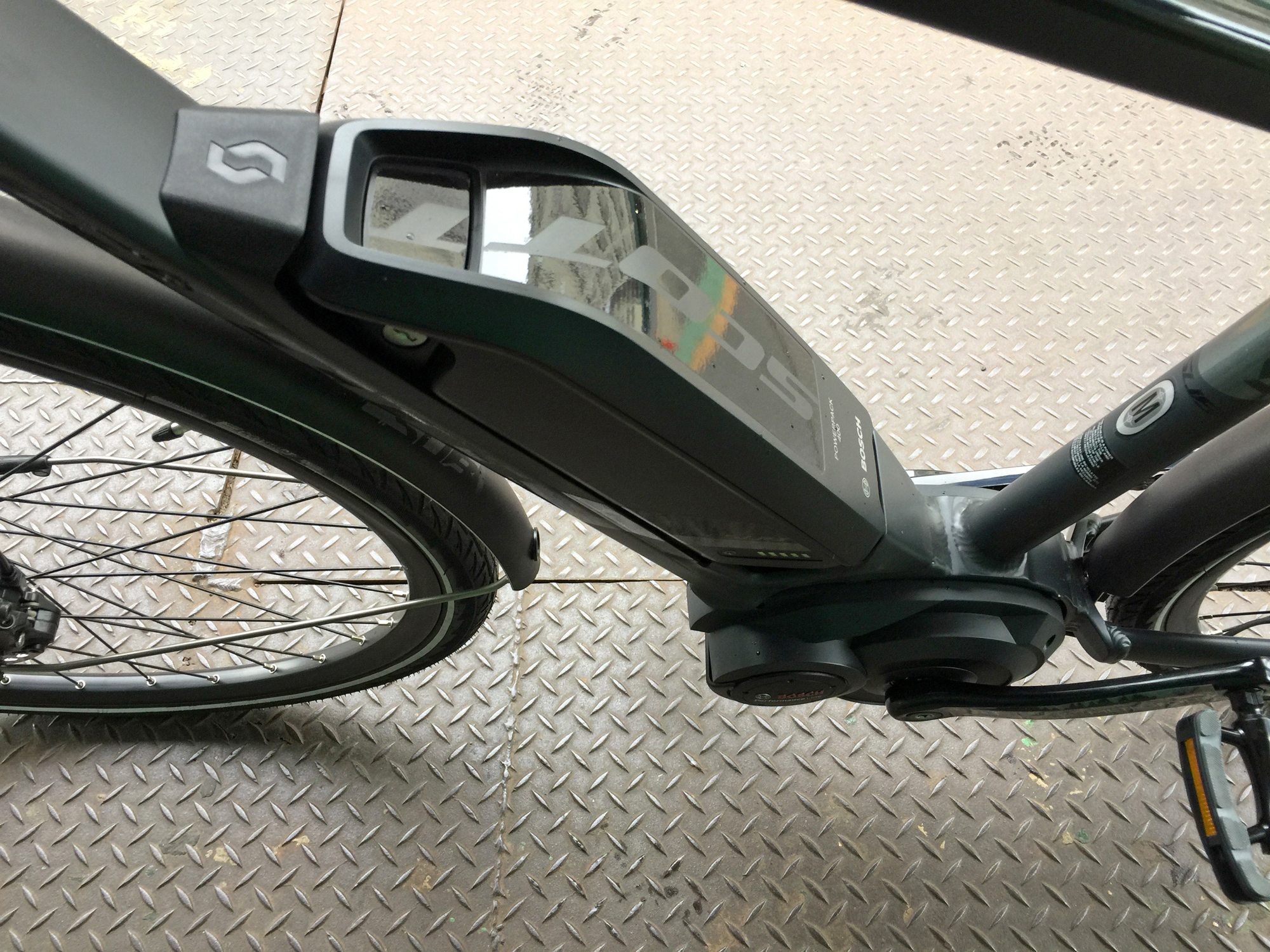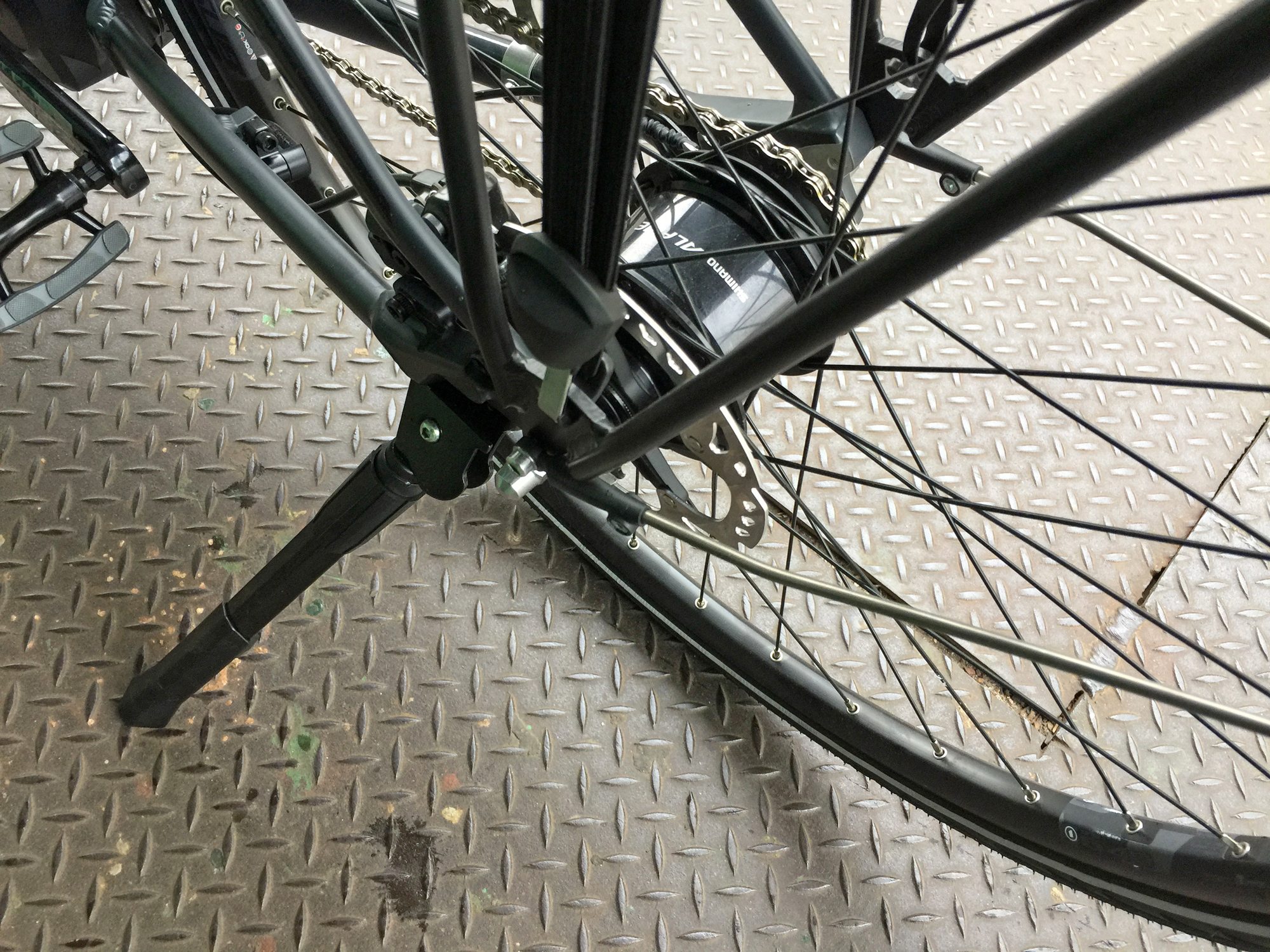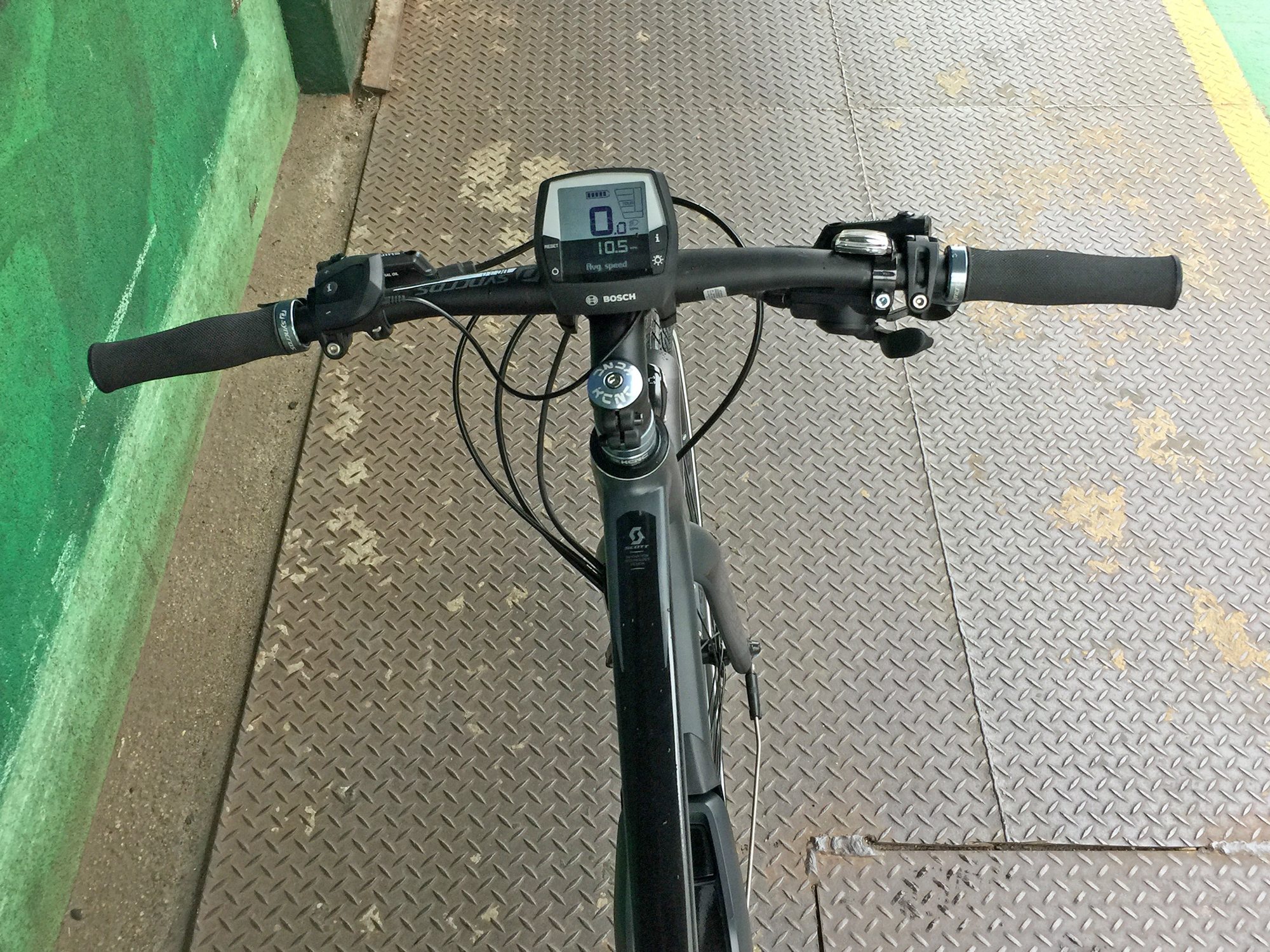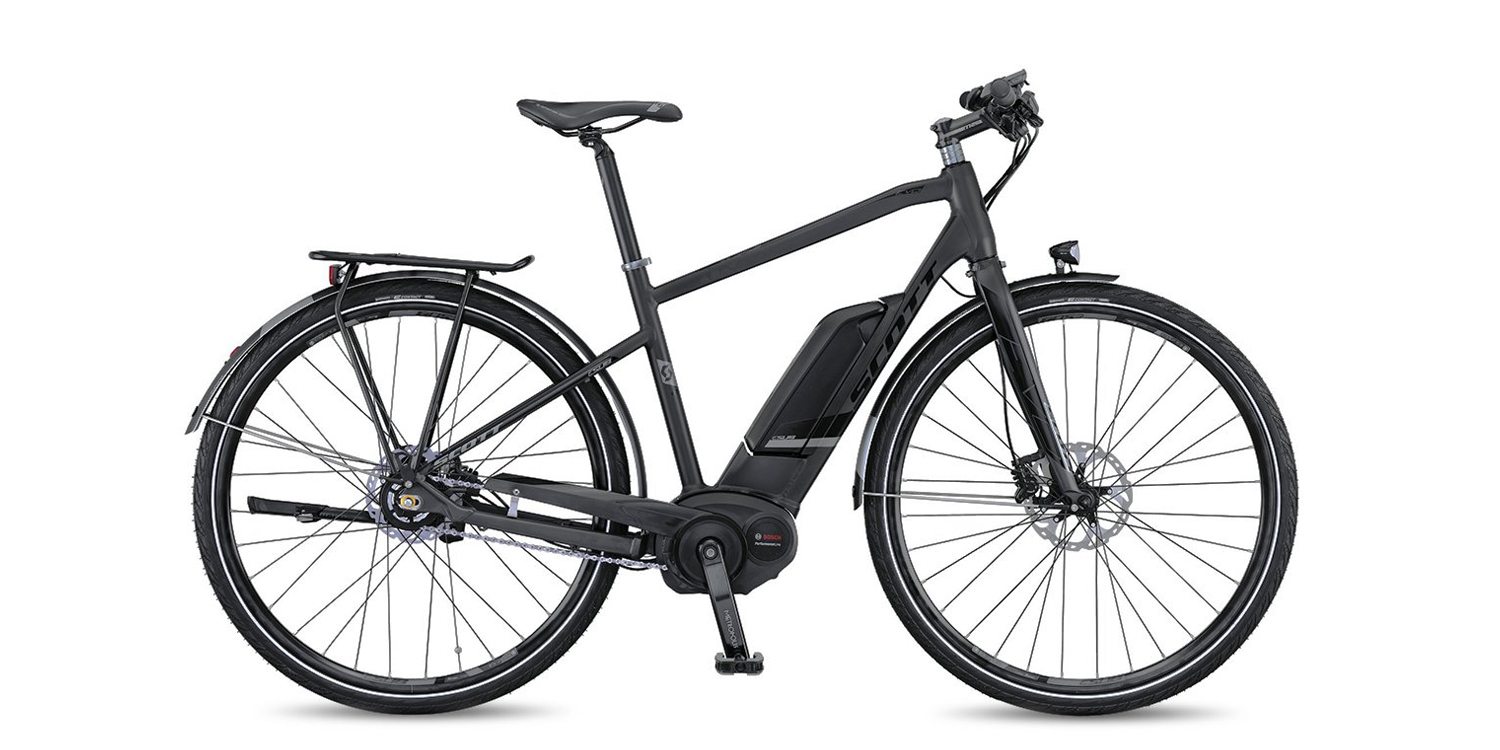This review is getting posted a little late because we’re at the end of 2016 (and it’s a 2016 year model) but it was my first chance to see and test ride the Scott electric bikes. I visited Propel Bikes in Brooklyn New York to see it and the owner, Chris, and I rode around town to get a feel. The first thing I noticed was that this is a more rigid sporty commuter… there’s no suspension fork or suspension seat post and the tires are sort of medium in terms of width and cushion, offering up to 85 PSI vs. 30 to 60 on some of the larger balloon and min-balloon. Now that said, the bike rides efficiently, translating nearly all of your pedaling power through the pedals, cranks and frame directly into speed vs. wasting it on bobbing. At just under 50 lbs, it delivers massive utility and durability without compromising style. Notice how the downtube looks thin from the side but is actually wide and flat when viewed from above. The battery pack mounting interface smooths out gaps and draws the base of the pack in towards the motor and seat tube. There isn’t one single thing that hides the battery or the motor and there are definitely other e-bikes that are more discreet with these components but for a Bosch powered ebike I feel like Scott did a great job! And there is a lot of benefit going with Bosch and having a battery that isn’t mounted inside some sort of proprietary downtube. The Bosch Powerpack used here is easy to access, charge on or off the frame and can be removed, along with the display, quickly and easily for protection when parking at the rack outside. Same with the front wheel, it has a quick release skewer so you can take it off and lock it to the frame with a U-lock.
Powering the bike is a standard Bosch Performance Line Centerdrive with the older style black plastic casing. It’s a bit larger visually than some of the newer bikes but still looks good. You get 350 watts of power nominally with an impressive 63 Newton meters peak output. That’s enough to mountain bike with… and I have done this successfully with other models. To me it’s more than enough power to climb in the city, it zips you up to speed (when riding in higher power levels) and responds incredibly quickly as you pedal then stop pedaling… there’s virtually no lag. One drawback to this and most Bosch systems I’ve tested is a distinct high pitch whirring sound produced in the higher power levels and as you pedal at higher RPM. You can hear it in the video review but please note that I was riding in Turbo (the top level of power). The motor delivers shift sensing performance that isn’t perfectly suited to an internally geared hub but still reduces some of the grinding and mashing that might occur if otherwise absent. All in all, it’s one of my favorite drive systems because it’s so efficient. As you switch gears, the motor benefits from improved mechanical advantage (towards power or speed) and it supports higher RPM pedaling which is my preferred riding style (having a sensitive knee). It uses a combination of rear wheel speed, pedal cadence and pedal torque to respond and keeps some of the heavier weight of the system (nearly nine pounds of motor weight) super low and centered on the frame.
Powering that motor along with the backlit display and two LED light systems is an award winning battery pack with reliable Samsung cells. The Bosch Powerpack 400 has been available in the US for several years now and is getting an upgrade for 2017 to 500 watt hours for even longer riding. But the 400 is still an excellent pack and the interface it connect to is forward compatible so you could buy the 500 separately at any point if you’d like. The battery uses light weight Lithium-ion cells, can be charged on or off the bike and has a little handle at the top making it easy to hold and carry (and charge in the office at work perhaps). Normally I gripe about the visuals of having a big pack on the downtube but Scott did a wonderful job making it blend in here… My only complaint is that they didn’t include bottle cage bosses on the seat tube! To me it looks like there is plenty of room and I was testing the smaller frame size (of which there are two) so it feels like there is no excuse? Why Scott!! For those who want to approximate this without modifying the frame using rivnuts, consider a strap on bottle cage mount for use with folding locks, mini pumps or water bottle cages.
Not only is the Scott E-Sub Evo beautiful, it’s utilitarian and tuff. Rather than use a traditional derailleur that could get bent at the side (especially when parking or if tipped) they went with an eight speed Shimano Alfine internally geared hub. These weigh a touch more but have the added benefit of using just one sprocket so your chain stays tight and quiet. It worked well enough in my tests but does perform a bit differently when shifting, and while it can shift at standstill there seems to be a moment of delay when shifting under power. At the left side of the rear hub is a kickstand mount and Scott included an adjustable length stand that works well. The tires chosen are name brand Continental with Safety Plus puncture protection and the grips up at the front are locking… the fenders didn’t rattle much (and are plastic with aluminum coating for stiffness and toughness) and the rack felt solid offering 55 lbs of storage with a spring latch, triple bungee cord and RackTime horizontal slide-on holes. This review gave me a chance to speak with Chris and get his feedback about why he chose Scott and what I heard was that he’s going for more and more Bosch powered electric bikes in general. The display system is easy to use and reliable, he has never had a motor failure and the company is large and trusted… even if Scott, Felt, Haibike or one of the other large brands that uses Bosch went out of business, their motors and batteries would still be available from other companies and Bosch directly. That’s a great feeling if you’re planning to use a bike like this for your primary mode of transportation and you NEED it to work every day without fail. Sure, we all get flat tires and stuff but there’s going to be way less tuning required with an internally geared hub and if you take the screen and battery off… the rest of the bike is super tuff. My only considerations are around comfort and dialing this in to work for your environment and your physical needs. The two frame sizes help but the high-step only frame and rack (with possibly a bag attached) means that mounting could be a trick for some with flexibility challenges. I either swing my leg around the back or tip the bike way over to one side to step on. Ultimately, a high step diamond style frame like this is going to be tougher, lighter and easier to mount on some racks than a comparable step-thru so I get it. Good stuff, looking forward to more Scott electric bikes in the US in the future :)
Pros:
- Sleek frame design and battery integration… the Bosch Powerpack 400 that bolts on top of the downtube always stands out a bit visually in my opinion but with the Scott E-Sub they flattened the interface and created some plastic and metal surrounding that help it to meld into the overall design nicely, the black accents on the frame also match it
- Solid commuting accessories that match the frame, reduce rattling and don’t weigh a lot… the fenders are thin and tight but partially made from Aluminum, same with the chain cover and the rear rack is a bit of an upgrade with integrated bungee cords
- Nice visibility features including an integrated LED headlight and another LED Light built into the fender! This one is especially cool because it stays out of the way if you’ve got bags on the rack, I also really appreciate the reflective tires and it’s neat that the headlight faces wherever you steer since it’s also fender mounted but may jitter a little as you ride over bumps if the fender vibrates (but the fenders are fairly stiff)
- Eight speed internally geared hub can be shifted at standstill and is less exposed to bumps and bike tips than a traditional derailleur, it adds a touch of weight but also keeps the chain tighter since there’s only one cog at the rear vs. a cassette
- Active saddle and semi-ergonomic grips performed well and were unique to me, Instead of an angled grip these sort of bulged in the middle and felt good, they are also locking
- Nice side mounted kickstand with adjustable length, it’s positioned towards the rear hub so you can tinker with the pedals and drivetrain while the bike is at rest and not have your crank arms collide
- Industry leading display panel and battery pack from Bosch are both removable for safe storage if you commute with this electric bike, they also reduce the overall weight but ~5.5 lbs if you take them off before mounting on a car rack or similar
- The battery pack can be charged on or off the bike and the mount is forward compatible with the new 500 watt hour Powerpack so you could go further or just get a nicer replacement someday, these downtube Bosch batteries are very common and plentiful, you could bring a second pack easily using the rack and maybe a pannier if you wanted to go trekking or touring
- I think the motor is well integrated and blends in about as well as it can, the color scheme of the bike and they way they positioned frame elements goes a long way… Of course these mid-drive bikes are well balanced physically and the mid-mount battery also helps this
- High quality Shimano hydraulic disc brakes with adjustable reach levers give you excellent stopping power and are easy to use without as much effort as mechanical brakes
- I like that the LCD display panel, Bosch Intuvia, has a micro USB port on the top right side, it can output ~6 volts to maintain your portable electronics when mounted to the bike
- Given the added accessories on this bike, I feel like the weight is pretty low at around 50 lbs, it’s nice that they also produce it in two sizes for improved fit (especially being more of a high-step)
- The shifter, brake and electrical wires are well integrated and hidden either inside the frame or under the fenders (in the case of the lights), the bike looks professional and you don’t have as much to worry about with snags as a result
- The Bosch Performance line motors offer a wide range of RPM operation so you can pedal with a slow or fast cadence and still feel like you’re getting help… some other middrive motors I test seem to fade out at higher RPM and that bothers me because I like to spin
Cons:
- I like the internally geared hub for a lot of reasons but it seems like occasionally they shift weird or take some getting used to, might require some help from a shop to tune perfectly or fix and they weigh more than standard derailleur + cassette drivetrains
- All-aluminum rigid frame makes this a responsive and tuff e-bike but it isn’t as comfortable and forgiving as others that have suspension forks, suspension seat posts and balloon tires, consider adding your own 31.6 mm suspension seat post like these, some cheaper ones can be found for under $40
- No quick release on the rear wheel (due to horizontal dropouts used for chain tensioning) and the seat post is also bolted on vs. qr. The front wheel is quick and easy to take off for reduced weight and storage but the fender is still there so it’s just not as easy or quick to break this bike down and put it in your car, be extra careful with the fender
- There are no bottle cage bosses on the seat tube unfortunately, that means you’ll have to buy an after market part to use on your saddle rails like one of these or get a trunk bag with a bottle slot like this… bit of a bummer since it appears that there would have been plenty of space for bosses and I like to use them for folding locks and mini-pumps when I’m not bringing my bag
- The Bosch centerdrive 350 motor offers shift sensing but it doesn’t seem to work as well with internally geared hubs, the Shimano Alfine used here does offer some of its own delay when shifting presumably so it won’t grind (so it doesn’t shift until the forces being applied either by pedaling or the motor have eased off), this can be a bit wonky feeling at first and it’s not just on this specific bike
- Given that this is a high-step with a rack and fender setup, it’s easier to bonk your shin or foot on the rack when mounting (if you swing your leg over like I do), just keep this in mind… not a huge con of the bike, more of a consideration
- The Scott E-Sub Evo costs about $1,000 more than their E-Sub Tour model (which doesn’t have the internally geared hub) this is quite a large price jump in my opinion
Resources:
- Official Site: https://www.scott-sports.com/
- More Pictures: https://goo.gl/photos/Eev2uA9ki55rgKLCA











Joe says
How do you remove the rear wheel to access the kick stand bolts? My bolts have come loose but you can’t reach them with a wrench because the internal hub blocks access. Do you have any advice?
Court says
Hmm, I’m looking at the picture in the review with the kickstand shown and it appears to have a bolt on it that could be unscrewed without removing the rear wheel. If for some reason you do need to remove the rear wheel, I think you can just use a wrench to remove the bolts that secure the axle on the sliding dropout… or take it to a bike shop and ask for some help if you don’t have the tools or are uncomfortable/unfamiliar with this sort of thing :)